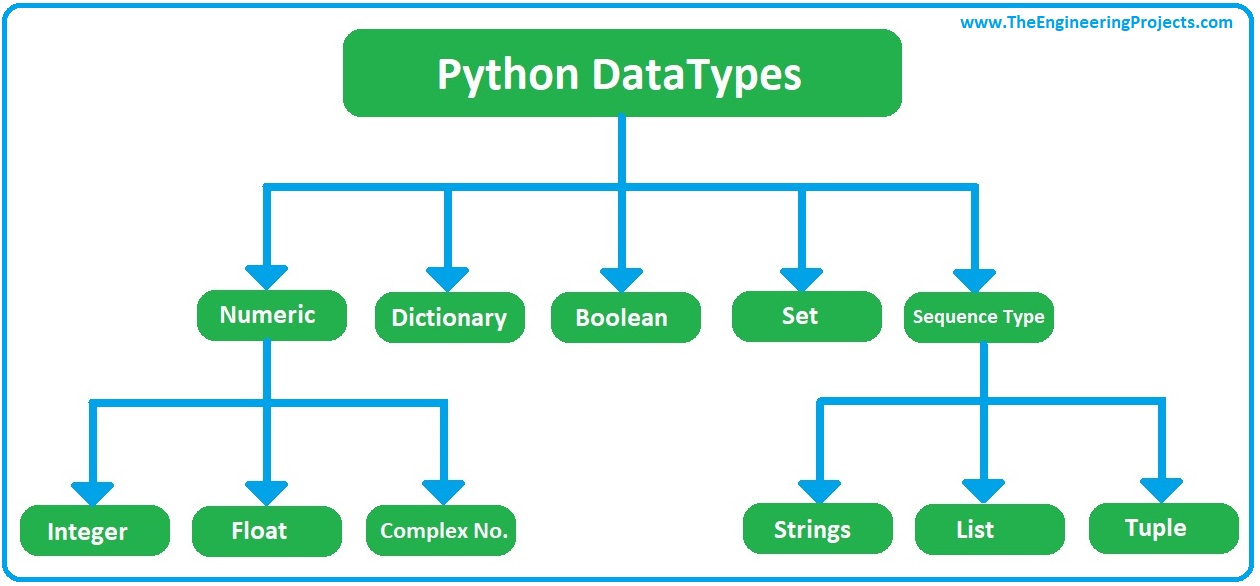🌈 데이터 타입(data-type)
🔥 python은 6가지 데이터 타입이 존재
- Numeric Types: int(정수), float(소수), complex(복소수)
- Sequence Types: str(문자열), list(리스트), tuple(튜플)
- Mapping Type: dict(딕셔너리)
- Set Types: set(집합)
- Boolean Type: bool(불리언)
- Binary Types: bytes, bytearray, memoryview

✍🏻 pyrhon
# 데이터 타입 v_str1 = "Niceman" #str v_str2 = "Goodgirl" #str v_bool = True #bool v_float = 10.3 #float v_int = 7 #int v_complex = 3 + 3j v_dict = { "name" : "Jang", "age" : 32, "city" : "seoul" } #dict v_list = [3,5,7] #list v_tuple = 3,5,7 #tuple v_set = {7,8,9} #set # print(type(v_str1)) # <class 'str'> print(type(v_str2)) # <class 'str'> print(type(v_bool)) # <class 'bool'> print(type(v_float)) # <class 'float'> print(type(v_int)) # <class 'int'> print(type(v_complex)) # <class 'complex'> print(type(v_dict)) # <class 'dict'> print(type(v_list)) # <class 'list'> print(type(v_tuple)) # <class 'tuple'> print(type(v_set)) # <class 'set'>
1. Numeric Types : Int / Float / Complex
- Int(정수형) : 숫자형의 하나로 소수점이 없는 정수
- Float(소수형) : 숫자형의 하나로 소수점이 있는 실수
- Complex(복소수) : 실수와 허수의 합인 복소수
- 일반적으로 수학에서 가능한 모든 기능을 사용할 수 있음
- import math를 통해 수학적 기능을 확장시켜 활용 가능
✍🏻 python
# 사칙연산 # 덧셈(+), 뺄샘(-), 곱셈(*), 나눗샘(/), 몫(//), 나머지(%), 제곱(**) a = 10 b = 2 print(a+b) # 12 print(a-b) # 8 print(a*b) # 20 print(a/b) # 5.0 print(a//b) # 5 print(a%b) # 0 print(a**b) # 100#단항 연산자 x = 100 x += 100 # x = x + x print(x) #200 y = 100 y /= y # y = y / y print(y) #1.0 z = 7 z *= z # z = z * z print(z) # 49 m = 99999999 m -= m # m = m - m print(m) # 0# 수치 연산 함수 print(abs(-7)) #절대값 : 7 n, m = divmod(100,8) print(n, m) #12 4import math print(math.ceil(5.1)) #올림 : 6 print(math.floor(3.874)) #내림 : 3
2. Sequence Types : Str / List / Tuple
1) 문자형(str)
- 문자열(String)이란 문자, 단어 등으로 구성된 문자들의 집합을 의미함
✍🏻 python
# 문자열 만들기1 : 큰따옴표(")로 양쪽 둘러싸기 print("Hello world!") # Hello python!# 문자열 만들기2 : 작은따옴표(')로 양쪽 둘러싸기 print('Hello world!') # Hello python!# 문자열 만들기3 : 큰따옴표 3개를 연속(""")으로 써서 양쪽 둘러싸기 print("""Hello world!""") # Hello python!# 문자열 만들기4 : 작음따옴표 3개를 연속(''') print('''Hello world!''') # Hello python!# 문자열에 '를 포함시키고 싶을 때 : 큰따옴표("")로 묶어줌 print("Python's is favorite food is pizza") # Python's is favorite food is pizza# 문자열에 "를 포함시키고 싶을 때 : 작음따옴표('')로 묶어줌 print('"Hi, Dave" he says.') # "Hi, Dave" he says.# 문자열에 큰따옴표(")나 작은따옴표(')를 포함시키고 싶을 때 : 왼쪽에 \(역슬래쉬) food = 'Python\'s favorite food is perl' print(food) # Python's favorite food is perl say = "\"Python is very easy.\" he says." print(say) # "Python is very easy." he says.# 줄 바꿈 위한 이스케이프코드(\n) 삽입하기 multiline = "Life is too short\nYou need python." print(multiline) # Life is too short # You need python.
- 문자형은 문자를 다룰 수 있는 다양한 추가, 삽입, 수정, 삭제 기능을 제공함
- 길이 구하기, 인덱싱, 슬라이싱, 갯수 세기, 위치 찾기, 삽입, 대체하기, 나누기 등..
✍🏻 python
# 문자열 길이 구하기 : len() getlength = 'python is cool' print(len(getlength)) # 14# 문자열 인덱싱 indexing = "Life is too short, You need Python" print(indexing[3]) # e -> 0번부터 시작, 3은 4번째 자리 print(indexing[-1]) # n -> -1은 뒤에서부터 시작해 1번째# 문자열 슬라이싱 slicing = "Life is too short, You need Python" print(slicing[0:4]) # Life -> [x:y] x부터 y전까지 문자열을 뽑아옴(끝 번호 포함 안함) print(slicing[:]) # Life is too short, You need Python print(slicing[:4]) # Life print(slicing[18:]) # You need Python print(slicing[-1:7]) # Python# 문자 갯수 세기(count) count_str = "lalalalalballlballballballllblblblblaaaa" print(count_str.count("l")) # 20 -> count_str 중 l의 갯수를 가져옴# 위치 알려주기(find) find_str = "python!" print(find_str.find("!")) # 6 -> !표가 6번째 자리에 위치함 print(find_str.find("a")) # -1 -> a가 find_str안에 없음# 문자열 삽입(join) join_str = "python" join_str = "python" print(".".join(join_str)) # p.y.t.h.o.n print("-".join(join_str)) # p-y-t-h-o-n# 소문자를 대문자로 바꾸기(upper) a = "hi" print(a.upper()) # HI# 대문자를 소문자로 바꾸기(lower) #python a = "PYTHON" print(a.lower())# 공백지우기 : 양쪽 공백 지우기(strip) / 왼쪽 공백 지우기(lstrip) / 오른쪽 공백 지우기(rstrip) a = " hi " print(a.strip()) # hi# 문자열 바꾸기(replace) a = "Life is too short" print(a.replace("short", "long")) # Life is too long# 문자열 나누기(split) : ()안에 있는 문자열을 기준으로해서 문자열을 나눈 후 나눠진 값을 리스트 넣어줌 a = "Life is too short" print(a.split()) # ['Life', 'is', 'too', 'short'] b = "a:b:c:d" print(b.split(":")) # ['a', 'b', 'c', 'd']
2) 리스트(list)
- 리스트를 사용하여 데이터를 묶어서 사용할 수 있음
- 불필요하게 각 각의 변수를 생성하여 데이터를 하나씩 담아줘야하는 문제점을 개선
- 리스트는 문자형처럼 인덱싱(indexing)과 슬라이싱(slicing) 사용 가능
- 또한, 수정, 삭제, 추가, 정렬, 뒤집기, 삽입 등 모두 가능
✍🏻 python
# indexing : 리스트내에서 위치값으로 원하는 요소 추출하기 indexing = [1,2,3,4,5] print(indexing) # [1,2,3,4,5] print(indexing[0]) # 1 print(indexing[0]+indexing[-1]) # 6 => 1+5 indexing = [1,2,3, ["a","b","c"]] print(indexing[0]) # 1 print(indexing[3]) # ["a", "b", "c"] print(indexing[3][-1]) # c# slicing : 리스트내에서 위치값으로 원하는 가져오기 slicing = [1, 2, 3, ["a", "b", "c"], 4, 5] print(slicing[2:5]) # [3, ['a', 'b', 'c'], 4] -> 두번째부터 다섯번째 전까지 가져옴(마지막 숫자 포함안함)# 리스트 값 수정하기 a = [1,2,3] a[2] = 4 # 2번째 자리를 4로 바꿈 print(a) # [1, 2, 4]# 리스트 값 삭제하기(del) a = [1,2,3,4,5,6,7,8,9,10] del a[9] # 9번째 자리수 삭제 print(a) # [1,2,3,4,5,6,7,9] del a[3:] # 3번째자리수 이후 모두 삭제 print(a) # [1, 2, 3]# 리스트 값 추가하기(append, extend) a = [1,2,3,4,5] a.append(6) # 리시트 a에 요소로 6을 넣음 print(a) # [1, 2, 3, 4, 5, 6] a.append([7,8,9,10]) # 리스트 a에 [7,8,9,10] 리스트를 내부리스트로 넣어줌 print(a) # [1, 2, 3, 4, 5, 6, [7, 8, 9, 10]] b = [1,2,3,4,5] b.extend(["a","b","c","d"]) # append는 배열안에 배열로 추가하지만, extend는 확장시킴 print(b) # [1, 2, 3, 4, 5, 'a', 'b', 'c', 'd']# 리스트 정렬(sort) a = [1,4,3,2,5] a.sort() # 오른차순 정렬 print(a) # [1, 2, 3, 4, 5]# 리스트 뒤집기(reverse) a = ['a', 'b', 'c', 'z', 'f', 'i'] a.reverse() print(a) # ['i', 'f', 'z', 'c', 'b', 'a']# 리스트 요소 삽입(insert) a = [1,2,3] a.insert(0,10) # 0번째 자리에 10을 넣어줌 print(a) # [10, 1, 2, 3]# 리스트 요소 제거(remove) : 첫번째로 나오는 요소를 삭제해줌 a = [1,2,3,1,2,3] a.remove(3) # 리스트에서 첫번째로나오는 3을 삭제 print(a) # [1, 2, 1, 2, 3]# 리스트 요소 끄집어 내기(pop) - 마지막 요소를 꺼내주고 기존 리스트에서 해당 요소를 삭제 a = [1,2,3] print(a) # [1,2,3] a.pop() # 맨 뒤에 요소 1개(3)를 끄집어 냄 print(a) # [1,2] a.pop() # 맨 뒤에 요소 1개(2)를 끄집어 냄 print(a) # [1] a.pop() # 맨 뒤에 요소 1개(1)를 끄집어 냄 print(a) # []# 리스트에 포함된 요소 x의 개수 세기(count) a = [1,2,3,1] b = ["a", "b", "c", "a", "d", "e", "a"] print(a.count(1)) # 2 -> a 리스트에 1이 2개 있음 print(b.count("a")) # 3 -> b 리스트에 a가 3개 있음
3) 튜플(tuple)
- 튜플은 2가지 점을 제외하고는 전반적으로 리스트와 유사함
- 차이점1. 리스트는 []로 감싸지만, 튜플은 ()로 감쌈
- 차이점2. 리스트는 요소의 생성, 삭제, 수정이 가능하지만 튜플은 그 값을 바꿀 수 없음
- 다만, 튜플은 인덱싱, 슬라이싱, 더하기, 곱하기, 길이구하기 처럼 기본적인 것은 가능
- 덧셈은 튜플끼리도 가능하지만, 곱셈은 튜플에 숫자를 곱해서만 가능(튜플끼리 곱셉 안됨)
- 또한 튜플이 1개의 값을 갖고 있다면 값 뒤에 콤마(,)를 찍어줘야하고, ()를 생략해도 가능
✍🏻 python
# 튜플 기본 tuple1 = () tuple2 = (1,) tuple3 = (1,2,3) tuple4 = 1,2,3 tuple5 = ("a", "b", ("ab", "cd", ("xyz",)))print(tuple1) # () print(tuple2) # (1,) print(tuple3) # (1, 2, 3) print(tuple4) # (1, 2, 3) print(tuple5) # ('a', 'b', ('ab', 'cd', ('xyz',)))# 튜플 다루기 # 튜플 인덱싱하기 tuple5 = ("a", "b", ("ab", "cd", ("xyz",))) print(tuple5[2]) # ('ab', 'cd', ('xyz',))# 튜플 슬라이싱하기 tuple5 = ("a", "b", ("ab", "cd", ("xyz",))) print(tuple5[1:]) # ('b', ('ab', 'cd', ('xyz',)))# 튜플 더하기 tuple3 = (1,2,3) tuple4 = 1,2,3 print(tuple3 + tuple4) # (1, 2, 3, 1, 2, 3)# 튜플 곱하기 tuple3 = (1,2,3) print(tuple3 * 3) # (1, 2, 3, 1, 2, 3, 1, 2, 3)# 튜플 길이 구하기(len) tuple5 = ("a", "b", ("ab", "cd", ("xyz",))) print(len(tuple5)) # 3 -> ("ab", "cd", ("xyz",) print(len(tuple5[2][2])) # 1 -> ("xyz",)# 튜플값 활용 : 변수값 스왑할 때! # 다른 언어들은 두변수의 값을 서로 바꾸기 위해서는 임시변수 temp등을 만들어 옮겨서 다시 넣어줘야함 # 튜플은 x,y = y,x로 간단하게 가능함 x = 3 y = 9 x,y = y,x print(x) # 9 print(y) # 33
3. Mapping Type : dict
1) 딕셔너리(dict)
- 자바스크립트에서 배열과 유사하기 key와 value를 갖고 있음
- 리스트와 같이 순차적인 index값을 요구하지 않고 key값을 통해 value를 얻음
- {} 중괄호로 감싸서 만들 수 있음. {key1:value1, key2:value2, key3:value3, ...key(N):value(N)}
- 요소를 추가, 삭제, 값 가져오기, 지우기 등...
✍🏻 python
# 딕셔너리 기본 형태 dict1 = {"name":"jawon", "age":20, "phone":"010-1111-2222"} dict2 = {1:"hi"} dict3 = {"a":[1,2,3]} dict4 = {}# 딕셔너리 쌍 추가하기 : 리스트 추가와 유사하나 []안에 키값을 넣음 dict1 = {1:'a'} dict1[2] = "b" # 추가 print(dict1) # {1: 'a', 2: 'b'} dict1["name"] = "jaewon" # 추가 dict1["age"] = 20 # 추가 print(dict1) # {1: 'a', 2: 'b', 'name': 'jaewon', 'age': 20} dict1[3] = [1,2,3,4] print(dict1) # {1: 'a', 2: 'b', 'name': 'jaewon', 'age': 20, 3: [1, 2, 3, 4]}# 딕셔너리 요소 삭제하기(del) : del dictName[key값] 으로 지울 수 있고, key:value쌍이 지워짐 dict2 = {"name":"jaewon", "age":"20", "location":"seoul", 1:"a", "list_a":[1,2,3,4,5]} del dict2["list_a"] print(dict2) # {'name': 'jaewon', 'age': '20', 'location': 'seoul', 1: 'a'} del dict2[1] print(dict2) # {'name': 'jaewon', 'age': '20', 'location': 'seoul'}# 딕셔너리에서 value값 얻기 # 리스트, 튜플, 문자열은 요솟값을 얻고자 할 때 인덱싱이나 슬라이싱 기법을 사용하였으나, # 딕셔너리에서는 key를 사용해 value를 구하는 방법을 사용함 # 왜냐하면 딕셔너리에는 index 순서가 없고, key으로 index 하기때문 a = {1:"a", 2:"b", "name":"jaewon", "age":20, "a":[1,2,3,4,5]} print(a[1]) # a print(a["name"]) # jaewon print(a["age"]) # 20 print(a["a"]) # [1,2,3,4,5]# get을 통해 value값 가져오기 -> 위 처럼 key를 통해 value를 호출할 수 있으나, 없는 key를 호출하면 오류가 발생함 # get을 통해 value를 가져올 때 존재하지 않는 key를 이용하면 None를 돌려줌 print("---------------") a = {'name':'pey', 'phone':'0119993323', 'birth': '1118'} print(a["name"]) # pey print(a.get("name")) # pey # print(a["location"]) # 오류발생 print(a.get("location")) # None 반환 print(a.get("location", "value is not")) # value is not 반환 -> 두번째에 미리 디폴트 값을 정해 없을때 호출할 수 있음# key 값을 순차적으로 추출하기 c = {'name': 'pey', 'phone': '0119993323', 'birth': '1118'} for k in c.keys(): print(k) # name, phone, birth -> 키값을 한개씩 불러올 수 있음# key값을 추출하여 리스트 만들기 : dictName.key() list_c_keys = list(c.keys()) # 키값을 뽑은 후에 리스트로 감쌈 print(list_c_keys) # ['name', 'phone', 'birth']# value값을 추출하여 리스트 만들기 : dictName.values() list_c_values = list(c.values()) print(list_c_values) # ['pey', '0119993323', '1118']# key, value 쌍으로 리스트에 넣기 : dictName.items() list_c_items = list(c.items()) print(list_c_items) # [('name', 'pey'), ('phone', '0119993323'), ('birth', '1118')]# key와 value값 모두 지우기 : dictName.clear() d = {"name":"jaewon", "age":20, "location":"seoul", "lulu":[1,2,3,4,5]} d.clear() print(d) # {}# 해당 key가 딕셔너리에 안에 있는지 확인하기(in) -> 있으면 True, 없으면 False 돌려줌 a = {'name':'pey', 'phone':'0119993323', 'birth': '1118'} print("name" in a) # True print("birth" in a) # True print("location" in a) # False
4. Set Type : set
1) 집합(set)
- 집합 자료형은 set 키워드를 사용해 만들 수 있음. 비어있는 집합 : set()
- 집합은 중복을 허용하지 않기 때문에 집합으로 변환시켰을 때 중복된 값은 제거됨(종종 중복을 없애는 필터 기능으로 사용됨)
- 집합은 순서가 없기 때문에 저장된 값을 인덱싱으로 접근 불가
- 집합에서 인덱싱으로 저장된 값을 저장하기 위해서는 자료형을 리스트나 튜플로 변환 후 제어해야 함
- 집합은 교집합, 합집합, 차집합을 구하는데 이용함
✍🏻 python
# set의 기본 형태 : 리스트형태나 문자열 형태로 만들 수 있음 s1 = set([1,2,3,1,2,3]) s2 = set("Hello") print(s1) # {1,2,3} print(s2) # {'l', 'o', 'e', 'H'} -> 중복이 제거됨# 집합에서 인덱싱을 할 수 없기 때문에 요소값을 추출하려면 리스트나 튜플로 변환시킨 후 제어함 list_s1 = list(s1) # 리스트 변환 list_s2 = list(s2) # 리스트 변환 print(list_s1) # [1, 2, 3] print(list_s2) # ['e', 'o', 'H', 'l'] print(list_s1[1]) # 2 print(list_s2[1]) # H -> 계속 값이 바뀜,, 리스트로 바뀌는 과정에서 순서가 랜덤으로 위치함# 교집합, 합집합, 차집합 구하기 s1 = set([1, 2, 3, 4, 5, 6]) s2 = set([4, 5, 6, 7, 8, 9])# 교집합 : 교집합은 집간 간 공통으로 있는 요소를 추출함 print(s1&s2) # {4, 5, 6} print(s1.intersection(s2)) # {4, 5, 6}# 합집합 : 중복없이 집간 간 요소들을 모두 합침 print(s1|s2) # {1, 2, 3, 4, 5, 6, 7, 8, 9} print(s1.union(s2)) # {1, 2, 3, 4, 5, 6, 7, 8, 9}# 차집합 : 집합 간의 뺄셈 print(s1-s2) # {1, 2, 3} print(s1.difference(s2)) # {1, 2, 3}# 집합 관련된 함수들 # 값 1개 추가하기(add) : 1개만 가능 s1 = set([1,2,3]) s1.add(4) print(s1) # {1, 2, 3, 4}# 값 여러개 추가하기(update) s1 = set([1,2,3]) s1.update([4,5,6]) print(s1) # {1, 2, 3, 4, 5, 6}# 특정 값 제거(remove) s1 = set([1,2,3]) s1.remove(3) print(s1) # {1, 2}# set 활용 : 중복없음, 집합 연산 data1 = {"apple", "samsung", "lg"} data2 = {"samsung", "lg", "MS"} print(data1&data2) # {'lg', 'samsung'} -> 교집합 print(data1|data2) # {'lg', 'MS', 'apple', 'samsung'} ->합집합 print(data1-data2) # {'apple'} -> 차집합 print(data1^data2) # {'MS', 'apple'} -> 합집합-교집합#중복 없애기 data_list = ["apple", "samsung", "lg", "samsung", "lg", "MS", "dell", "HP", "dell", "HP", "samsung"] # {'dell', 'samsung', 'MS', 'lg', 'HP', 'apple'}
5. Boolean Type : bool
- 불 자료형은 참(True)와 거짓(False)로 나타내는 자료형임. 이 2가지 값만 가질 수 있음
- 빈 자료값("", (), {}, [] 등), 숫자 0, None 는 False, 나머지는 True
- 조건문과 함께 활용
🌈 형변환(type change)
- type() 함수를 통해 형변환을 할 수 있음
✍🏻 python
int1 = 10 int2 = 200 float1 = .5 float2 = 10. #형변환 int(정수), float(실수), complex(복소수) print(int(float1)) #0 print(int(float2)) #10 print(float(int1)) #10.0 print(complex(3)) #(3+0j) print(int(True)) #1 print(int(False)) #0 print(type(int(True))) #class 'int' print(type(int(False))) #class 'int' print(int('7')) # 7 print(complex(False)) #0j

